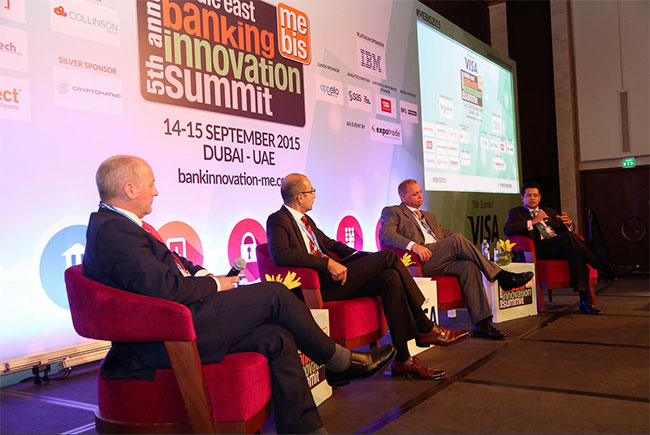Key Take-aways and Learning
During the Middle East Banking Innovation Summit 2015, organized by Expotrade Global in Dubai on 14-15 Sep 2015, the speakers presented their views about different aspects of innovation, and how is banking industry taking the path of innovation. The question, How much/what kind of innovation is enough/real innovation is often debated in the industry circles and organisations board rooms? While the ‘once- in-a-blue-moon’ Disruptive innovations are the ones which really transform an industry or a company, the importance of marginal and continuous innovation cannot be ignored for any business organisation.

The banks and other industry partners are investing heavily on innovation at all levels, and lot of work seems to be happening at the back stage, here are some of the key areas that are coming to the fore now:
1. Digital Banks
Banks and Service Providers such as Visa, and technology set-ups alike are working towards digitizing the banking experience to the next levels. Banks are looking at creating automation and digital experience right from customer on-boarding to collections management. Enabling secure online payment, educating customers about it, and providing enough motivation to customers to opt for it (instead of cheque and cash) are the endeavors that leading banks are taking up.
Ever since the arrival of ATMs, things have changed a lot in the last two decades, the endeavour to minimize the visits of a customer to the bank branch are still on. One of the leading banks in the UAE, Emirates NBD now has a feature in its mobile app which allows customers to click a picture of the cheque and send it via the app. The cheque gets deposited in the customer’s account. Isn’t that really simple! Banks are also looking at institutionalizing the age old method of doorstep delivery of cash by way of launching Mobile ATM for corporate – a bank in Poland is already doing that!
2. Online Payments and Authentication
Industry seems to be moving from Swipe-in or Chip Credit cards for making payments to Contactless payment options. This technology innovation aims at speeding up the payment at retail counters – minimizes queuing up and slowing the retailer ops – and at the same time giving a super quick check-out to shoppers. The same applies to the online payments too; online shoppers will need to feed in their details only once, and rest would be taken care of by way of authentication from the next purchases onwards. Technology leaps by Apple (Apple Pay) and other players – Android/ Samsung are soon catching the fancy of the customers. New age technologies like voice recognition and voice biometrics are also creating dents in some parts of the banking world. Wearables and beacons are seeing growing acceptance amongst organisations and customers, their success in future would largely be defined by how well they get accepted by the customers.
As regards online shopping, cash-on-delivery still rules [In UAE, 88% payments are cash-on-delivery, and only 9% are online – card payments (by volume)]. A huge majority of online shoppers are still coming to terms with making online payments and developing their faith in online sellers. Players like Twitter and Facebook are now facilitating social banking, allowing customers to pay using these social media sites.
Security still remains one of the prime concerns for the potential online customers. There are players creating newer ways to ensure higher levels of security. Tech companies, like Oberthur Technologies have come up with mechanism like Motion Codes, which embed dynamic cryptogram into the cards, which changes the key digits in a credit/debit card number every few minutes. This is another leap ahead of OTP which get delivered on the mobile phones
3. Effective CRM and Loyalty
A loyal customer adds more to both the top line and the bottom line of any business, and banks are no exception. A well crafted loyalty programme not only encourages the customers to deal more and more often with the bank, it also adds value to their lives, at large. As against most of the earlier prevalent loyalty programmes which allowed customers to accumulate air miles (high perceived value – low frequency benefits), the new ones launched by banks enable banks to get closer to their customers and developed more entrenched relationships (low value-higher frequency). One of the leading banks in UAE, Abu Dhabi Commercial Banks (ADCB) has played its role very well by allowing customers, on the one hand, to create baskets of their purchases (Grocery, Fashion, Fuel etc.) to earn bonus points on their cards. On the other end of the programme, they also allow the customers to redeem their points at multiple points (once again – Utilities, Fashion etc.). Needless to say, such programmes go a long way to create loyal customers who go on to become ambassadors for the brand.
4. Design Thinking and Culture
Design Thinking is the new philosophy that is circling around even in the banking industry. Bringing design to the core of any business, rather than a fringe/ad-hoc function is being considered by many. Design is also being considered an integral part of any innovation project, more than ever before. A lot of top notch organisations are now setting up separate Design Studios or Design Labs, which allow and foster creative thinking and ‘Innovation’ culture.
5. Strategic Partnership
Banks partnership, with organisations like Visa the one hand, and with technology players (e-pay, m-pay, mobile apps etc.) on the other, are becoming more pronounced. This augurs very well for the industry and the customers, as innovation no longer remains the responsibility of any one of the partners, but comes out as a joint, single minded focus of all who want to create a difference! Ideas can come from any of such players, and if adapted and executed well could shift the paradigm for the industry and the customer!
At the end of it all, the big questions that are still playing around in everyone’s minds are:
So is the society going to turn into a cashless society? If yes, what is the time frame that one can consider?
Images Source: Flickr
